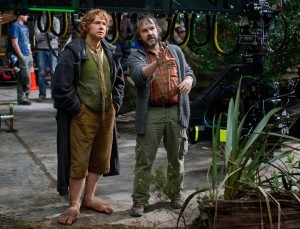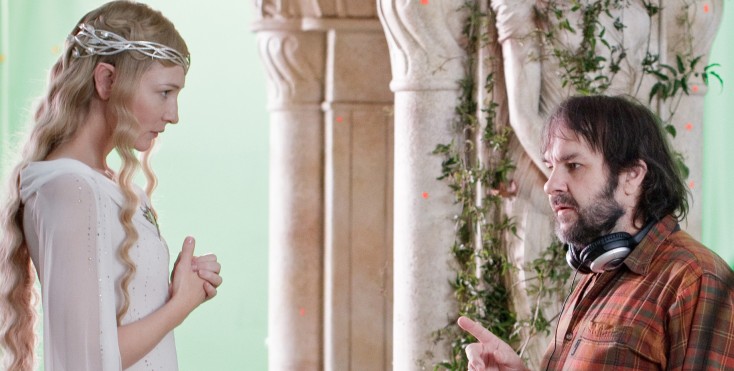
(L-r) MARTIN FREEMAN and director PETER JACKSON on the set of the fantasy adventure “THE HOBBIT: AN UNEXPECTED JOURNEY.” ©Warner Bros. Entertainment/MGM.
By ANGELA DAWSON
Front Row Features
NEW YORK—“The Hobbit,” the long-awaited prequel to “The Lord of the Rings” trilogy is hitting theaters. It was a long journey for filmmaker Peter Jackson, who poured himself into the first trilogy based on the books by J.R.R. Tolkien, earning him many accolades, including three Academy Awards (Best Picture, Best Director and Best Screenplay) for 2003’s “The Lord of the Rings: The Return of the King.”
The New Zealand filmmaker initially was going to sit out the prequel and let another director take a crack at Middle-earth and its adventure-loving inhabitants. Unavoidable delays and casting concerns conspired to keep the beloved novel from reaching the screen.
Ultimately, Jackson decided to direct “The Hobbit,” which he will tell in three parts, starting with “The Hobbit: An Unexpected Journey.” The lighter, fluffier “Hobbit,” stars Martin Freeman (“A Hitchhiker’s Guide to the Galaxy,” “The Office”) as young Bilbo Baggins, who embarks on a journey with a dozen dwarfs to help them reclaim their kingdom from a fearsome dragon. It also reintroduces some familiar names to this fantastical universe as well—Andy Serkis as Gollum, Elijah Wood as Frodo Baggins and Ian McKellen as Gandalf, to name a few.
Jackson, who co-wrote the script with Fran Walsh and Philippa Boyens, with whom he previously collaborated on “The Lord of the Rings” trilogy, recently spoke about bringing Tolkien’s work to the big screen again.
Q: Why three films from a slender children’s story?
Jackson: That’s a good question. It kind of surprised us a bit too. We were originally doing two films. It’s really a question of what you leave out. It’s a misleading book because it’s written at a very breathless pace. Major events happen over two or three pages. It’s like a children’s story. We developed the scenes and did a little bit more character development than the book. Plus, we can adapt the appendices, which is 100-odd pages that Tolkien developed that takes place around the time of the “The Hobbit.” Tolkien himself wrote that to tie into “Lord of the Rings.” So all those factors combine and give us the material to do it.
Q: How did you end up casting Martin Freeman as Bilbo Baggins?
Jackson: Martin is the only person we ever wanted for the role. That was before we met him. We knew him from “The Office” and “Hitchhiker’s Guide to the Galaxy.” We felt he had qualities that were perfect for Bilbo—that very essential fussy English quality. He’s a dramatic actor who has a rare comedic skill. So that was going to be important. There was a lot more comedy in “The Hobbit” than in “Lord of the Rings.” It’s comedy of a fish-out-of-water nature. It’s Bilbo reacting in a reluctant way to the adventures. We met him early in pre-production and we really locked into him for the role. The delays that happened were mostly due to the MGM financial situation. We couldn’t offer the role to anybody and we couldn’t do anything contractually.
Q: It was rumored that you nearly lost Martin and you thought you might have to look for someone else to play Bilbo. True?
Jackson: By the time we offered him the role, he had already accepted the “Sherlock” TV series, and by that time the first season had shot but the second season was going to be right in the middle of “The Hobbit.” He said, “Look, I can’t do it.” We were in trouble. I was panicking. We looked at other actors but unless we got this bit of casting right we knew we were going to be in enormous trouble. I was having sleepless nights.
Q: How did you resolve the problem?
Jackson: We were about six weeks away from the beginning of the shoot and I was tormenting myself by watching “Sherlock” on an iPad at 4 a.m. I was sitting there and looking at Martin and thinking there is nobody better (and) this is a nightmarish situation. When I got up that morning I called Martin’s agent and asked if we could accommodate Martin’s schedule for “Sherlock” within our shoot would Martin still be interested. Fortunately, the answer was yes. What we did with the studio’s approval, we started shooting “The Hobbit” for four or five months, and then stopped the shoot for eight weeks. Then when Martin came back we carried on. It was a blessing for us, too, because I got to edit the first four months of shooting, I got to prepare for the next batch of shooting and that little break was very welcome. It was quite a civilized way to make a movie at the end of the day, plus we got Martin.
Q: Why did you originally not want to direct “The Hobbit?”
Jackson: The truth is I guess I thought that I wouldn’t enjoy, because I thought I’d be competing with myself and I thought it would be interesting to have another director (do it). And Guillermo (del Toro, who was originally signed to direct, worked on the script for the initial two films and provided voluminous character designs) was there for a while—over a year. With the delays, we had another six months after he left. I was enjoying it a lot more. We (Philippa Boyens and Fran Walsh) were writing the script with Guillermo and developing it throughout this time. Another thing I hadn’t put my head around was that there was a lot of charm and humor in “The Hobbit.” It’s a completely different tone. This is not “Lord of the Rings.” This gives me an opportunity to do something different. I thought it would be a lot of fun. And it was. The first day of shooting I was incredibly happy I was there.
Q: There has been quite a lot of discussion in the media about your use of the 48 frames per minutes versus the traditional 24 frames per minute. Why do you believe in this high-definition frame rate?
Jackson: The levels of detail are similar to “The Lord of the Rings.” With the HD cameras, you see more so you can see more detail. Fortunately, the team we had in New Zealand—the WETA Workshop, who design everything—have always wanted to put in a lot of detail. To me, fantasy should be as real as possible. I don’t buy into the notion that since it’s fantasy, it should be unrealistic. The levels of detail are very important. The 65mm film that people used to shoot in was virtually a high-definition of the film world, very fine grain film stock. When we were setting out to do “Lord of the Rings,” we explored doing it in 65mm. The camera equipment was very cumbersome and we were going to have to develop the film in America even though we were making (the films) in New Zealand. But it was something I wanted to do at that time. That big screen epic experience, the more immersive it is, is the sort of thing I like.
Q: And what do you say about the negative reactions to that format?
Jackson: I’m fascinated by the reactions. I’m tending to see that anyone under the age of 20 or so doesn’t really care and thinks it looks cool. They think the 3D looks really cool. I think 3D at 24 frames is interesting but it’s the 48 that allows the 3D (look) to achieve the potential that it can achieve because it (causes) less eyestrain and you have a sharper picture, which creates a more multi-dimensional world.
Q: How did you decide on that format?
Jackson: I had seen a couple of high frame-rate movies. I remember going to Disneyland and seeing the Star Tours ride, which is a high frame-rate film, where you’re speeding in the “Star Wars” spaceship. I had experience with it a few years ago when I directed a “King Kong” attraction for Universal Studios in California, which was a 60-frames-a-second 3D surround film on the tram ride. I thought, “Wow, this is so cool, I wish we could do a feature like this!” But the mechanical projectors in the cinemas around the world were locked into 24 frames.
The advent of digital projects allowed for this to happen. The editor we worked with went to a technical convention and when he returned he said, “If you’re interested in a high frame-rate, now is the time, because the projector manufacturers can probably do it and the cameras are going to be able to do it.” So we decided to take the plunge. Warner Bros. was very supportive. They just wanted some assurance that the 24 frames version would look absolutely normal, which it does. But once they were happy with that, they were happy, but we had to push that button that said 48 frames. When we started filming there probably wasn’t a cinema in the world that could project 48 frames in that format. It was a leap of faith.
Q: Do you think 48 frames will revolutionize cinema?
Jackson: The thing to realize is that it’s not an attempt to change the film industry. It’s another choice. The projectors that can run at 48 frames can run at 24 frames. You can shoot a movie in 24 frames and have sequences in 48 frames or 60 frames within the body of the film; you can do all the shutter angle effects, the “Saving Private Ryan” strobing effects. It doesn’t necessarily change the way films are going to be made but it’s another choice filmmakers can have. For me, it gave it more of that reality, that immersiveness. It makes it feel like you’re leaving the cinema seat and becoming a part of the adventure.




